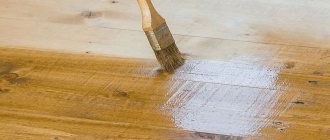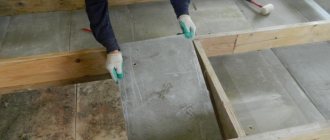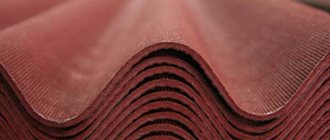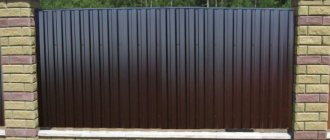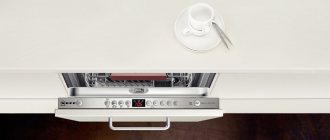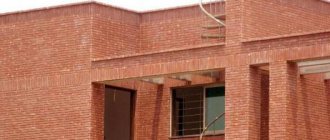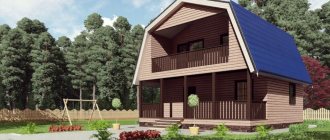The popularity of rounded logs in domestic house building is due to the fact that it allows you to assemble a classic Russian log house, like the one our ancestors built using chopped logs. New technologies have made adjustments to the preparation and characteristics of logs, making the construction process more technologically advanced and faster, and the constructed house more elegant, with smooth crowns and no cracks.
Let us consider in detail the properties and technical characteristics of rounded logs, what it is, what types and types there are, dimensions, parameters, pros and cons, how they are made and used in private construction.
Rounded logs - characteristics, types, sizes, pros and cons
What is a rounded log
A rounded log is milled lumber, which is a fragment of a trunk, cleared of the top, loosest layer of wood. Mechanical processing (milling) ensures the same diameter of the log along its entire length, which in turn increases the strength and stability of the geometry of the finished structure.
Production of rounded logs
The unique properties of rounded logs are acquired during its production process, which consists of the following stages:
- sorting of raw materials (saw logs) by diameter;
- processing in a rounding machine. After the milling stage, the top layer will be removed from the log, and only the core part will remain, which is the strongest and has the least shrinkage. Also, during processing, the difference in log diameters at the bottom and at the top will be minimized. According to the standard, it cannot exceed 4 mm;
- log sorting. Allows you to sort workpieces according to specified sizes;
- drying: natural or forced;
- formation of a compensation cut. Note that not all logs have a cut, and it is often done according to the buyer’s order;
- open.
The log goes on sale having a standard length. But many homeowners prefer not to bother with adjusting the logs to length, but order a house kit for their home. A house kit made from rounded logs is a ready-made kit for assembling a house. It resembles a construction set that contains a set of parts (logs) prepared in length in accordance with the provided house design, with the corresponding marking of each element. A significant advantage of using a house kit is the presence of seats (bowls), which make joining of logs quick and tight;
- bowling – involves cutting the seats (bowls) necessary for laying crowns from logs. Like a profiled beam, two types of seats are cut out in a rounded log:
– transverse bowls; Material prepared for the website www.moydomik.net
– diagonal bowls;
– longitudinal grooves. The curvature of the grooves is somewhat different from the curvature of the log. This is necessary in order to lay heat-insulating material at the junction of the logs. If the dimensions of the grooves coincide, then there is a high probability that after shrinkage the log will touch the bottom only with the central point, and not with the entire surface of the groove. This will lead to the fact that the junction of the logs will have to be caulked;
- trimming. End processing;
- antiseptic treatment. It is performed over the entire area of the log, including longitudinal grooves and bowls. Allows you to ensure biological inertness of the log and preserve its properties during storage, transportation and installation. Only water-based antiseptics are used. This solution does not clog the micropores of the wood, and it continues to dry;
- transportation to the construction site. Manufacturers often take on this function, as they can ensure the unloading and proper storage of logs on site. After all, a log house is built from 4 to 6 months, depending on its size and complexity of the project. During this period, it is necessary to organize proper storage of the material;
- storage;
- package.
Video description
About a log house with an external chimney in the following video:
- Environmental friendliness . Logs that have been treated with certified impregnations and varnishes are not harmful to health.
- Aesthetics . The natural texture of wooden walls will rarely leave anyone indifferent.
- Diversity . Ready-made projects (not to mention individual ones) amaze with the variety of exterior and interior design.
Wooden houses made from rounded logs have their own disadvantages, the negative impact of which can always be minimized:
- Shrinkage . Shrinkage (a property characteristic of any wooden structure) of one floor does not exceed 5-8 mm per meter of height (for a log of natural humidity - 10-15%).
Screw jacks of vertical supports compensate for changes in wall height during shrinkage Source www.ecotechstroy.ru
Rounded logs - GOST, regulations and standards
Please note that there is no single regulatory document regulating the production and characteristics of rounded logs. Neither in Russia, nor anywhere else at all.
Self-respecting manufacturers develop their own standards - StP (StO) - the standard of an enterprise (organization), which contains all the information about the dimensions and deviations, quality and storage conditions of the material.
However, there are a number of state standards (GOST) that regulate certain aspects of the production and storage of rounded logs:
GOST standards for rounded logs
And a number of international standards (ISO) and European standards (EN):
ISO for rounded logs
Characteristics of rounded logs according to GOST 9463-88
Russian cutting
A round log is used, the extensions of the crowns extend beyond the plane of the frame. The logs are connected using semicircular bowls that completely repeat the profile of the adjacent log. Longitudinal grooves in the logs ensure a tight fit of the crowns. Bowls and grooves are located in both the lower and upper crowns.
Cutting "in the oblo"
A bowl and groove in the lower crown is a less labor-intensive option. Log houses are assembled faster because there is no need to turn over logs to complete operations. But this design is the most vulnerable; atmospheric moisture gets into the bowls, the connections diverge over time and large cracks appear. The situation is aggravated when the logs dry out, so constant insulation is required.
Cutting "in a big way" (Siberian bowl)
An improved version of Russian cutting. This is an inverted version of the traditional technology - the bowl and groove are selected in the upper crown and “look” down. This protects against precipitation, but this technology requires great skill, because during operation the logs are constantly turned over.
Cutting "in the tail"
A thorn (“fat tail”) is created in the Russian bowl. A groove in the adjacent log is selected for it. The tongue-and-groove connection is strength and tightness. After shrinkage, the gaps in such log houses are minimal. The bowl with the fat tail is oriented up or down. For the reasons stated above, downward orientation is considered preferable. This is a complex technical solution, but it is in demand due to its high performance characteristics.
Types of rounded logs
All types of logs can be classified as follows:
| Classification feature | Detailing |
| Processing type | - chopped log . In this case, the cylindrical shape is given to the log using a hand plane. They also cut the bowls. This type of log is suitable for those who love the natural style of the Russian hut - log house; – rounded log . Processing is carried out on a rounding machine, due to which ideal geometry and precision of the seats (grooves and bowls) are achieved. |
| Type of drying | – log of natural moisture . The vast majority of products on the domestic market are of this type. This is due to the fact that it is quite difficult to ensure uniform drying of the original log, and the cost of the product increases; – thermal log or dried round log . Today, manufacturers are mastering the production of an improved product - rounded logs with a given moisture content (18-20%). What it is and its main properties are described below. |
| Type of profile (groove) | – lunar; – Finnish. |
| Wood species (in descending order of popularity and increasing cost) | – pine: Karelian and Arkhangelsk; – spruce; – cedar; – larch; – deciduous species. |
| Groove location | – longitudinal – along the log strictly in the center; – diagonal – used to create non-standard shapes, for example, bay windows; – transverse – landing bowl. |
| Dimensions | – diameter: 160-320 mm; – working height: 139-272 mm. (depending on the diameter of the log); – length: 1...6 m.p.; |
Characteristics of thermal logs
Thermal logs are lumber made from thermally modified logs. The new technology involves heat treatment of wood - high-temperature drying of logs in an airless environment.
Features, properties, pros and cons of thermal logs:
- drying at a temperature of 125-190 °C. The choice of temperature depends on the density of the wood;
- complete absence of resin. At the same time, coniferous wood retains its aroma;
- change at the level of cellular structure. Drying allows you to obtain a log with a given humidity, which eliminates the appearance of blue on the surface of the log. In this case, no chemicals are used;
- color correction. Thanks to the effect of heat, varying the exposure time and temperature, the manufacturer has the opportunity to give the wood noble dark shades. In this case, the color change is not end-to-end, i.e. does not affect the entire log, but is deep enough (1-2 cm), which eliminates the appearance of light scratches on the surface of the wall;
- decrease in thermal conductivity. After heat treatment, wood loses its ability to transmit heat by 0-30%;
- increase in surface strength, which increases the log’s resistance to cracking;
- reduction of hygroscopicity due to modification of its capillary structure;
- no torsion defects;
- resistance to biological activity;
- environmental cleanliness;
- increased durability.
The disadvantage is the high cost.
Pricing Features
The price depends on the location of extraction, quality of processing, type of wood, humidity.
The price of lumber per cubic meter depends on the diameter. Approximately: 180 – 190 mm – 7500 rubles, 220 – 230 mm – 7800 rubles, 260 mm – 8000 rubles, 300 mm – 9500 rubles, 320 mm – 11000 rubles.
Price varies depending on factors:
- presence of a diagonal groove;
- type of packaging (film, pallet, tape);
- making holes for installing dowels;
- milling space for window and door trim;
- milling of recesses for installation of window and door fillings;
- impregnation with protective agents.
The final cost is affected by the delivery price . If construction is carried out in steppe regions, delivery will significantly increase the cost of the material.
View of the profile (groove) of a rounded log
The profile or longitudinal groove is selected along the entire length of the rounded log and is designed to ensure a tighter fit of the logs along the length during installation.
Lunar groove
The lunar profile is a longitudinal cut of a semicircular shape. It has become more widespread due to the simplicity of the device.
Lunar groove of rounded log
Characteristics of rounded logs with lunar profile
Marking, diameter, working height, groove width, volume m.cub.
Finnish groove
It has a more complex tongue-and-groove installation system. It has so-called shoulders - cuts that increase the thermal insulation properties of the joint. The Finnish groove allows you to reduce damage from cracks to a minimum. At the same time, the use of a Finnish groove allows you to abandon the procedure of caulking log walls.
Finnish groove of rounded logs
Characteristics of rounded logs with Finnish profile
Marking, diameter, working height, groove width, volume m.cub.
Note. According to the thermal calculation data, a log with a Finnish profile with a diameter of 220 mm. Thermal insulation is equivalent to a log with a lunar profile with a diameter of 280 mm.
How to choose the right project
When choosing a project from among ready-made ones, it is useful to first think through the requirements for your future home. Finished houses made of rounded logs are designed, as a rule, for operation in a certain climatic zone. Among other parameters, the appearance (and price) of the house is influenced by:
- Area and location of the site . If the area is small, you should think about a two-story project (a spacious one-story house will take up too much usable space). The choice of location for a terrace or balcony often depends on the road passing nearby.
- Soil and groundwater level . They influence the choice of foundation.
- Method of operation . The house in which you and your family will live permanently will require the use of more massive logs (with a diameter of 240 mm).
- Family members and pets . For everyone, you need to provide a personal place - some in the bedroom, and some in the yard.
Second light in the interior of a timber house Source homycomfort.ru
- Car (often - cars). It is necessary to provide not only a convenient garage or parking space, but also carefully consider the entrance.
- Environment style . If you do not want to destroy the harmony of the cottage community (and relationships with neighbors), take a closer look at the style of the neighboring areas.
An individual project for a house made of rounded logs, the price of which is formed from several other parameters, allows the customer to influence many things:
- Reduce the cost of your home . This can be achieved by reducing the number of corridors and combining some rooms (the kitchen-dining room or kitchen-living room option is often chosen). When designing, some rooms are made into walk-through rooms, and a study is arranged on the balcony.
- Reduce heat loss at home . Savings are achieved by eliminating the complex shape of the house and roof, and minimally using protrusions, balconies and bay windows.
- Reduce costs . Correct external orientation of the house (to the cardinal points and wind rose) will help reduce heating and air conditioning costs.
House made of rounded logs with extensions Source thewalls.ru
- Provide for expansion . Sooner or later, an addition to the family will require an increase in living space. It would be good if the possibility of arranging an extension or an attic would be taken into account.
- Fireplace . It's better to add it while drafting. It is quite difficult (and much more expensive) to do this in an already built log house.
- Ladder . If there is one, make sure it is well lit (for safety). A window in the right place can save you from a lot of trouble.
Wood type
Pine is most widely used in construction due to its optimal price-quality ratio. The distinctive features of pine rounding are its beautiful structure, strength, relatively low thermal conductivity, resistance to external influences and affordable price. Arkhangelsk pine stands out because it practically does not crack.
Spruce can be considered an analogue of pine. It has fewer knots and is easier to process.
As for cedar, its spread is hampered by its high price.
The same judgment is true for larch. Which is the most suitable raw material for the production of rounded logs. Larch is resistant to temperature changes and moisture, has high density and strength. However, the cost of a rounded larch log is twice the price of a similar pine log. Such characteristics of larch logs have led to the fact that it is used as the main one when forming the lower crown of a log house.
Comparative characteristics of materials
The timber has higher thermal insulation values and is easier to install
In the private sector, logs and beams for the home are used everywhere. The choice regarding a particular technology is made based on priority criteria. The main characteristics of each material should be studied and compared.
They are summarized in the table:
| Index | Log | timber |
| Manufacturability | Average | High |
| Thermal insulation | Low | High |
| Biological resistance | Average | Average |
| Hygroscopicity | High | Average |
| Strength | Low | Average |
| Ecological cleanliness | High | Average |
| Durability | Average | High |
| Presentability | High | Average |
| Construction speed | Average | High |
Dimensions of rounded logs
During the logging process, logs are sorted before being processed. A trunk with the correct parameters allows you to obtain lumber with the specified dimensions.
Standard log sizes:
- diameter (section) of a rounded log . This parameter is of greatest importance, since it directly determines the thermal conductivity and reliability of the walls.
The diameter of the log varies between 160-320 mm. The most popular in private construction is a rounded log with a diameter of 240 mm.
Section (diameter) of a rounded log (180, 200, 220, 240, 260 mm)
What diameter of log is needed for year-round use?
The choice of diameter when building a house is determined by its purpose and location:
| Log diameter | Purpose | Location |
| 160-180 mm | Cottage, bathhouse, outbuilding | Southern regions |
| 200 mm | Summer house, cottage, bathhouse, outbuilding, gazebo, garage | european part of Russia |
| 220 mm | Seasonal house, cottage, guest house, bathhouse, gazebo | european part of Russia |
| 240-260 mm | Houses of permanent residence with insulation. Recommended for one-story houses with an area of more than 250 square meters, two-story houses and houses with an attic | Western Siberia |
| 280-320 mm | Year-round houses with attic insulation. Designed for one-story houses with an area of more than 250 square meters, two-story houses and houses with an attic. | Western Siberia |
- working height of a rounded log . This indicator determines how many crowns should be laid to achieve a given wall height. The working height is calculated by measuring the distance from the top point of the log section to the top of the groove. The type of groove also affects the working height. For example, the working height of a rounded log with a diameter of 240 mm is 208 mm. (if there is a lunar groove) and 190 mm (if there is a Finnish groove).
- length of rounded log . Standard length – 6.m.p. or a multiple of 1.m.p. By special order it is possible to produce logs with a maximum length of up to 12 m. However, this will significantly affect the cost of the product, because There will be a significant amount of waste during the production process. This is due to the significant difference in trunk diameter over a tree length of 12 m.
- groove width . With an equal log diameter (for example, 220 mm), the Finnish groove will be wider (140 mm) than the lunar groove (110 mm). There is also an extended lunar groove (20 mm wider).
Standard groove width for rounded logs
- compensation cut . The presence of a cut allows you to reduce internal stress in the log and prevent the appearance of a large number of gaps (cracks). The cutting depth (15-20 mm) is determined by the diameter of the log. In practice, it is a controversial decision, with many arguments for and against.
Unloading cut (compensation) on a rounded log
- cubic capacity of rounded log . As a rule, lumber is sold in cubic meters. The volume of the log, depending on the type of profile (groove), diameter and length of the log, is given in the table.
How to calculate the cubic capacity of a rounded log mathematically?
- calculate the cross-sectional area of the log;
- multiply the resulting value by the length of the log;
- round to the nearest whole number.
Rounding parameters
As a rule, rounded logs are produced according to standard parameters, thanks to which projects of various designs are implemented. The photo shows standard product sizes
- The standard length of a ready-made whip is 6 meters; if a non-standard product is required, manufacturers will be able to make it, only the cost will be slightly higher.
- For the construction of houses, various outbuildings and baths, a product with a diameter of 12-20 cm is used; this size allows you to protect the walls of the structure from freezing.
- For capital construction, a product with a diameter of 22-28 cm is used.
Modern technologies make it possible to produce high-quality products, with the help of which houses with smooth, durable and warm walls can be easily built.
Environmentally friendly materials are increasingly used in modern construction. Wood is used in the construction of private farmsteads. Gazebos, bathhouses and even houses are built from logs. This material allows you to build not only housing that is most suitable for living, but also significantly saves the construction budget. Therefore, the production of rounded logs looks like a promising and profitable business.
- Where to start producing log rounding
- How much profit does a company specializing in log rounding make?
- What financial investments do you need to make to open your own log rounding shop?
- What equipment to choose for log rounding
- Preparation of necessary documents
- Tax regime
- Production technology
Opening a wood processing workshop is quite simple. The technological process is simple and no special permits or licenses are needed. Workers may have low qualifications. One technologist who knows the process and knows how to control the operation of the equipment is enough. Such an enterprise will be profitable only when the volume of finished products is at least 250 cubic meters. per month. Log rounding is often complemented by other activities. Along with this business, it is best to carry out the construction of houses or small architectural forms made of wood
. Large companies involved in the construction of such buildings often open their own production of materials.
A significant disadvantage of the business is its seasonality. Construction work usually stops with the onset of cold weather. That is why in winter it is necessary to find an alternative to income from cylindering logs.
Physical properties of rounded logs
- thermal conductivity. The table shows a comparison of the thermal conductivity of a log and a brick wall at different freezing temperatures.
- soundproofing . Thanks to the structure of the wood, the log does not transmit sound well, which allows you to avoid the penetration of external sounds and enjoy silence in a log house;
- strength . Caused by the presence of resin in coniferous wood and larch;
- dimensional stability . Achieved through the use of high-quality equipment. Material prepared for the website www.moydomik.net
Subtleties of design: log house styles
Rounded logs are a proven way to implement a variety of architectural solutions. Interesting projects appear thanks to the use of high-quality technological material that is easy to process and install. Today, outside the city you can find not only classic cottages in a traditional style, but also original houses in a variety of styles.
Turnkey construction of houses from rounded logs increasingly appears to be a profitable investment. Construction organizations with their own design bureau offer the design and construction of a country cottage in various styles, among which the most popular are:
- Classic log house . The house, in national traditions, occupies one of the leading places among houses built from rounded logs. The decoration of such a building is a high porch with balusters, carved platbands and a massive door.
Modern style log house Source hehongyuanlin.com
- European style . A classic of European house building, the chalet style, finds its admirers far from the Alps. Customers are attracted by the monumentality of the design, the elegance of the finish and the large veranda (often on the second floor).
- Scandinavian style . Northern winter is famous not only for its cold, but also for its short daylight hours. The large glazing area (including panoramic windows) is dictated by the lack of sun. Traditionally, the windows and doors of Scandinavian housing are decorated with dark trim; The roof is preferably gable or flat. Solar panels are often found on modern houses.
For premium-class houses, the highest quality logs with a diameter of 320 mm are used; the decoration is often a gable roof with an attic located underneath. This project allows you to expand the total area of the house by placing an additional bedroom, a children's playroom, a personal office or a billiard room in the attic.
Turnkey houses made of round logs are often ordered along with small architectural forms - high-quality bathhouses, romantic gazebos and guest houses. The joint architectural ensemble transforms the garden area, giving it integrity.
Timber house with a chalet-style barbecue area Source designs-projects.ru
Advantages and disadvantages of rounded logs
The log has both the advantages and disadvantages inherent in wood. Some properties can have a negative effect, but are largely associated with improper wood processing. Therefore, most negative qualities are leveled out by the right approach to selection and care. Analyzing the reviews and characteristics of cylindering, we can highlight a number of positive and negative parameters.
Advantages of rounded logs:
- the same diameter along the entire length of the log. This is the key difference between a rounded log and a chopped log. This characteristic determined other positive properties of the log;
- identical longitudinal grooves and cuts. Such precision is ensured by the use of high-quality cutters; such a quality connection is impossible when using chopped logs;
- ease of assembling a house from a log. This is possible due to the presence of a longitudinal groove, and in the house kit also due to the presence of transverse grooves (bowls) or diagonal grooves;
- resistance to external weather factors: ultraviolet radiation, temperature changes, humidity, mechanical damage, etc.;
- resistance to biological activity. Achieved by high-quality processing of logs on all surfaces;
- the ability to implement a complex design project;
- attractive external and internal appearance of a log house;
- environmental cleanliness and creation of a favorable indoor microclimate;
- low thermal conductivity.
Disadvantages of rounded logs
- shrinkage. The log, losing moisture, gradually shrinks, the value of which is 5-8%. This property is characteristic of all lumber, only each of them has its own shrinkage rate;
- improper processing of logs can lead to walls swelling from dampness;
- cracks appear as the house is used. The tendency to crack is another property characteristic of all wood building materials;
- the need for additional processing of the log, the purpose of which is preservation and protection.
- flammability. Minimized by the use of fire retardants. Moreover, wood is a combustible, but far from flammable material. In addition, when burned, wood does not emit harmful substances, and its smoke is less caustic than that of other materials.
As you can see, with proper processing, all shortcomings can be quite easily eliminated.
Price and factors influencing it
The approximate cost of rounded chamber-dried coniferous wood logs (humidity 20%) is given in the table:
Note. If there is a bay window (the need to cut diagonal grooves), the cost increases by 10-15% of the price of the house kit.
Additionally, the following factors influence the price of a house kit made from rounded logs:
When rounded logs first entered the domestic market, its production was located in the northern and western regions of Russia, i.e. where there are raw materials. Today, with growing interest in this material, it can be bought almost everywhere and the cost of transporting logs is falling.
Video description
About the installation of a house made of rounded logs in the following video:
- Changes in wood characteristics . The material decreases thermal conductivity and hygroscopicity, but increases strength (which reduces cracking). House kits made from TMD can be stored for a long time without changing their properties.
A log made from TMD has improved characteristics that determine:
- Features about processing and . No protection against rot is needed, but external walls will require protection from solar ultraviolet radiation - waxing.
- Features of construction . The installation of the roof, the installation of windows and doors, and the laying of utilities begin immediately after the construction of the house frame. The day when the family celebrates housewarming will come much faster.
The material that gives the house longevity has one noticeable drawback - its high price.
House made of rounded logs with a swimming pool: the walls are protected with impregnation and colored oil Source maha.su
Care
Construction made from rounded logs requires some care. The material itself is good, but it needs to be cleaned and processed.
Many compounds, for example, fire retardants, suffer greatly from rain and other influences, so the coatings will have to be renewed periodically. The easiest way is to decorate the house with siding or tile, but in this case there will be no point in the natural appearance of the log. Therefore, they usually use stain or varnish; unfortunately, they retain their properties for no more than 3-4 years, no more.
The rounded log is also exposed to direct sunlight, which again does not have the best effect on the condition of the coatings.
- Without proper treatment, a variety of pests can appear in the tree. In case of construction in the summer season, the first outer layer of antiseptic should be applied after about 2 weeks
- In winter, this procedure can only be carried out at above-zero temperatures; it is even advisable to wait until spring and start working at about +10
- Impregnations are best applied using a spray gun: for 3-4 months they will protect the house from pests, fungi and mold
After this period, you can cover the wood with layers of coloring composition. This is where the treatment ends: indoors you need to repeat approximately the same thing using a water-based antiseptic. The wood tends to darken and become covered with gray or blue spots.
If this, however, could not be avoided, purchase a special whitening product: chloride-based powder. A thin layer of such a substance will help you quickly return the natural light shade to any wood. If desired, you can get rid of the darkened layer using a grinding machine, removing a layer of about 1-2 mm.
Stages of designing a machine yourself
Purchasing a professional installation for producing processed wood is an expensive proposition. But there is an alternative solution: you can make a machine for rounding logs with your own hands.
A sawmill is used as the base. The cone in the front part is replaced with a stop. A bearing is inserted into the tailstock. You will also need an electric motor to ensure the torsion of the log. The rotation can be manual, then you need to make a handle.
The cutter is assembled as a separate unit from a very durable material. Its movement can be ensured by laying rails. This is the path along which the cutter will move. In this design, the workpiece must be positioned along the rail and rotated so that the cutter slides along it.
Before installing the rounding machine, concreting (if not available) or compacting the area of the required size is carried out. Next, the frame sections are assembled and leveled in the horizontal plane. The maximum installation error should not exceed 0.5 mm per 1 m in all directions. Installation height 20 cm.
The subsequent assembly steps are as follows:
- installation of the power mechanism;
- installation of the front and rear headstocks so that their axes coincide and are parallel to the guides;
- fastening racks for cables for mobile power cables;
- cable tension;
- clamp-stop equipment for the power mechanism;
- grounding installation;
- connecting the motor and checking the direction of rotation of the lumber. The desired direction is regulated by changing the order of connecting the motor phases;
- mounting a shaped cutter on a conical part using bolts;
- screwing a universal cutter into the body of a figured cutter. In order to avoid imbalance, the knot is tightened with a wrench;
- checking for correct assembly.
A homemade machine requires preventive maintenance if it is idle for a long time or installed in a damp room.
The construction of a private house, cottage, or residential log house requires high-quality timber, which is processed using professional equipment. For technical buildings, you can round the wood yourself.
Classification
Experts propose to classify rounding machines according to five parameters:
- type of mechanism;
- the method of moving the log;
- level of automation;
- drive power type;
- diameter of the workpiece used (minimum – 80 m, maximum – 500 m).
Two types of mechanisms are used in installations. The first is a pass-through (rotary) one, which allows you to continuously move the wood through the cutter. The second is cyclic (turning), in which processing is performed by repeating a cycle of actions.
If cyclic actions are performed by a cutting tool, the machine is classified as a cyclo-pass type, and if a log moves, it is classified as a cyclo-positional type. In the mechanisms, logs have the ability to both rotate and move rectilinearly along the guides.
Offers for professional work
On the woodworking equipment market there are offers of any price category and for different technical needs. The most popular models are “Sherwood”, “Termite”, “Cedar”, “Taiga”, “Terem” with a full range of functions.
Technical characteristics are presented in the table.
| Model | Log length, mm | Diameter range, mm | power, kWt | Time to process one log, min |
| "Sherwood OF-28C" | 5950–6150 | 200–400 | 7,5 | 15–30 |
| "Termite 280OU" | 6200 | 160–280 | 22 | 30–40 |
| "Kedr OS-100" | 6200 | 160–240 | 7,5 | 15–30 |
| "Taiga OS-2" | 6200 | 160–240 | 9,8 | 30–40 |
| "Terem 8000V" | 8100 | 160–400 | 2,6 | 30–40 |
Types of rounding equipment
Depending on the technology, the log rounding machine is divided into:
- Passage – carries out wood processing while moving, without stopping.
- Cyclic – when processing wood, the movement of the log is interrupted. The movement pattern is a cycle of operations.
- And also cyclic installations are classified into two subtypes:
- Cyclo-positional - material processing occurs in the process of advancement relative to the tool
- Cyclo-passing - wood is subjected to woodworking with a tool that itself makes the necessary movements.
According to the mechanism of operation, the machines are divided into:
- Mechanical - require the presence of an operator who adjusts modes, configures, loads and unloads equipment.
- Automatic - the entire processing scheme is carried out by a machine. There are models where a person only needs to load the material.
- Semi-automatic - the installation automatically performs only one cycle of operations, and then the person must start the mechanism again.
A machine for rounding logs in the case of a separate type gives different productivity. Pass-through equipment is more productive, but inferior in terms of correct processing and the formation of pronounced roughness of the material.
Functions
The main function that any rounding machine has is the processing of logs as a body of revolution by milling. But to assemble a log house, simply cylindrical blanks are not enough. And in this case, additional equipment capabilities will come to the rescue:
- excavation of grooves to form various locking connections;
- production of parquet dies, timber;
- sawing of linear products;
- sawing timber into carriages and then into edged boards;
- all stages of log rounding, from roughing to final;
- removal of mounting bowls and compensation grooves.
In this case, the log itself is not reinstalled, but cutters and individual components are changed during the work. The result is parts with a wide range of diameters. The limitation concerns the length of the processed logs: the sleds are designed for seven-meter workpieces. A skillful combination of cutters and working techniques allows you to produce complex wooden structures.
